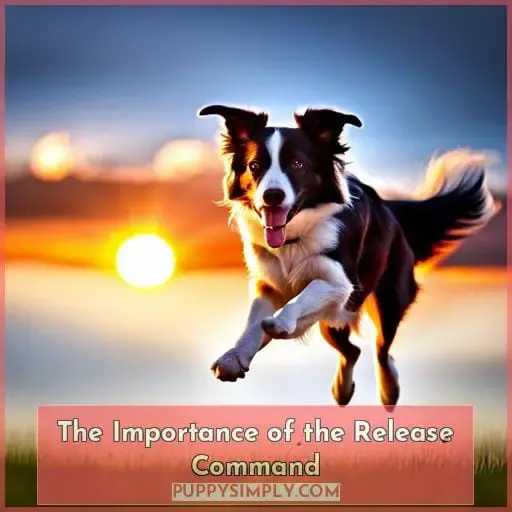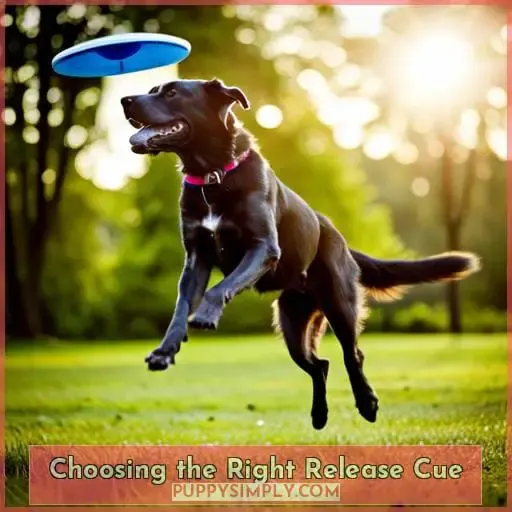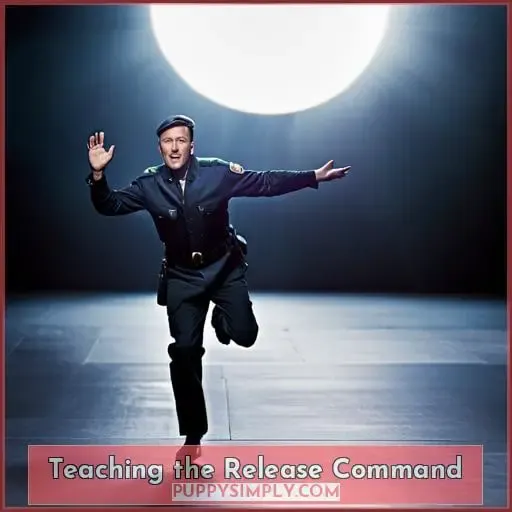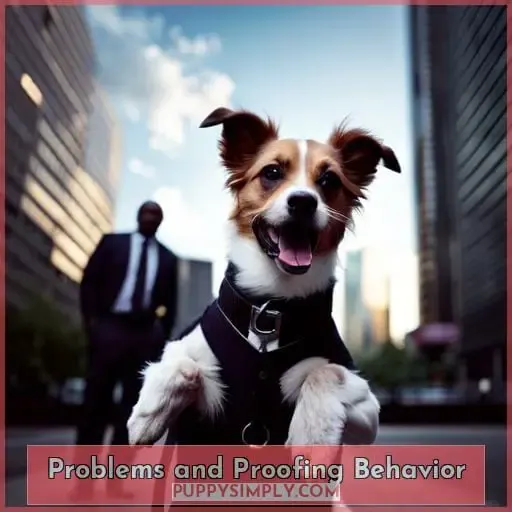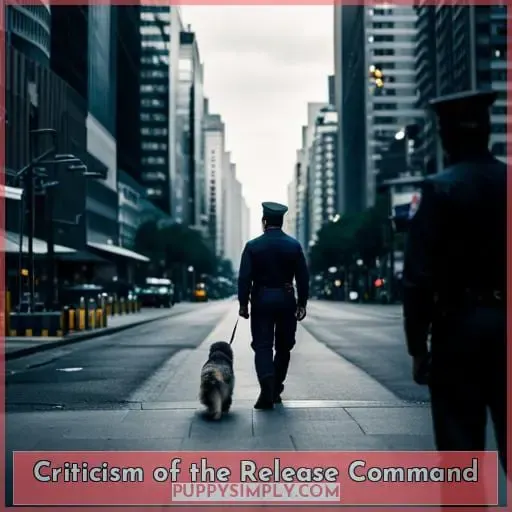This site is supported by our readers. We may earn a commission, at no cost to you, if you purchase through links.
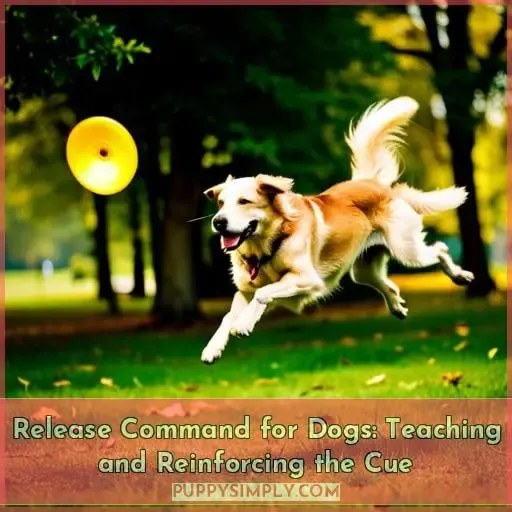 Are you ready to take your dog’s obedience training to the next level? Teaching them a release command is an essential step in helping them understand when it’s time for them to relax and disengage from their commands.
Are you ready to take your dog’s obedience training to the next level? Teaching them a release command is an essential step in helping them understand when it’s time for them to relax and disengage from their commands.
In fact, according to the American Kennel Club (AKC), nearly 80% of dogs that are trained with a release command have more reliable recall responses. This article will provide you with all the information needed on teaching your pup this important cue including why it matters, how to best choose and teach it, addressing problems during training, as well as criticism of using one.
So let’s get started!
Table Of Contents
Key Takeaways
- The AKC recognizes the release command as enhancing recall responses.
- It builds better communication and trust between owner and dog.
- It promotes safety by preventing accidents through controlled release.
- It develops the dog’s confidence and understanding of boundaries.
The Importance of the Release Command
By teaching your dog the release command, you can enhance communication between the two of you and help create a bond based on mutual trust. Additionally, this important cue helps to promote safety by preventing accidents or impulsive behavior in various scenarios and builds confidence in your pup as they understand their limits more clearly.
Enhancing Communication
By introducing a distinct release word and rewarding your pup for staying in place, you can easily enhance communication between you and your dog. Timing is crucial when reinforcing good behavior. Use verbal cues at the right moment, providing clear and consistent direction.
Focus on using reinforcement techniques to teach cues to dogs. This will help establish a strong connection between command, reward, and response. Verbal commands also allow dogs to bond with their owners through obedience training while reinforcing desired behaviors such as sit or stay.
With proper guidance and patience from trainers or pet parents, pets will understand the power of verbal releases.
Promoting Safety
You can promote safety by teaching your dog the release command. This provides a clear signal to end commands, prevents accidents, and boosts confidence. Utilizing positive reinforcement and reliable control is key in training scenarios for impulse control and avoiding leash greetings.
Building Confidence
Using the release command as part of your training regimen can help build your pup’s confidence in their abilities. Give rewards, such as treats or a favorite toy, for positive behavior patterns and successful completion of challenges.
Teaching patience to dogs through reward systems helps them handle fear better while boosting their confidence.
Choosing the Right Release Cue
Choosing the right release cue is an important step in effective dog training. Consistency and clarity are key, so choose a distinct word that everyone in your family agrees on.
Consistency and Clarity
To ensure your pup understands the release cue, it is important to remain consistent and clear with commands. Get family agreement on one phrase, such as okay, and use it each time you want them to get up from their bed.
Verbal clarity is key for effective training; be sure all cues are precise in order to maximize results. Consistency builds trust between pup and pet parent while providing a strong foundation for future learning.
Common Release Words
When teaching your pup a release cue, it’s important to choose a distinct word that everyone in the household will use consistently. Common words include: okay, break, and free. Using verbal cues for timing and transitioning techniques is crucial for successful training outcomes.
Keep in mind that recall commands are different from the release command – differentiate them clearly! Training with uncertainty can help build confidence when using the release cue during agility or any other activity where safety is paramount.
Family-wide Agreement
For successful training, it is essential that all family members agree on the same release word. A unified approach reinforces consistent and focused instruction and prevents undesired behavior. Coordinated instruction with a collective consensus will ensure harmony during training sessions and proofing behavior.
Choose a single word to act as an effective release command for dogs in various situations to promote desired behaviors while preventing any confusion or disruption from occurring during practice or real-life scenarios.
Teaching the Release Command
Training your pup to understand the release command is an important and fulfilling step in their education. Starting with a favorite toy, transitioning to treats, and adding a verbal cue are all key components of teaching them this valuable skill.
With knowledge, experience, and patience, you can master the art of releasing your dog from stay commands.
Starting With a Favorite Toy
Try out your dog’s favorite toy when introducing the release command. Engage with toys to effectively teach commands and transition to a unique cue word. Toy-based training games are an excellent way for distractible dogs to focus on their tasks and have fun! With practice, you can create toy-driven commands that make it easier for your pup to understand expectations in different scenarios.
Transitioning from toy play to obedience will become smoother and more rewarding if done correctly. Key to this is helping your pup build confidence through positive reinforcement during these activities.
Transitioning to Treats
Once your dog has mastered the release command with their favorite toy, you can transition to using treats as a reward. Start with positive reinforcement and treat variety, then focus on timing strategies and reward consistency.
With successful transitioning techniques, drop it or leave it commands are just as effective when used in combination with the release command, giving you more control over problem behaviors during training sessions.
Adding a Verbal Cue
Now, give your pup the opportunity to link a verbal cue with their release from stay by adding a special word. To help them understand this new command, use timing techniques and training progression strategies.
Reinforce desired behaviors with rewards and incorporate distraction challenges along the way.
Problems and Proofing Behavior
When teaching a release command for dogs, it is important to address confusion and distractions that can occur. Reinforcing the release command helps build understanding of this key element in dog training.
To do so, reward positive behavior when using the cue word and gradually introduce it with distraction-free situations first. This encourages quick responses from your pup while building trust between you both.
Addressing Confusion
If your pup is already familiar with the stay command but lacks a release word, you can help them learn through positive reinforcement and gradual introduction. Use various training techniques, such as extending waiting time or using visual cues, to overcome challenges.
Vary the release words used during practice sessions to further reinforce understanding. And remember, praise and reward are key to successful learning! Incorporate these proven methods into your dog’s training plan to address confusion surrounding their release command.
Dealing With Distractions
To further challenge your pup’s understanding of the release cue, introduce distractions during stay training. Manage their temptations with focus exercises and environmental challenges to test their commitment.
Sudden noises can also be used as controlled practice for overcoming distractions.
Reinforcing the Release Command
Reward your pup when they reliably respond to the release cue, encouraging them to associate it with positive reinforcement.
Timing strategies and proofing techniques help build their understanding of the command, no matter the distraction level.
Use a consistent signal each time you give this command – begin and end with a verbal or hand gesture that’s clear for your dog.
As they become more reliable in lay down commands at home, start introducing distractions like other dogs or people out on walks.
Gradually increase difficulty until they recognize and follow it even in challenging situations!
Positive reinforcement is key; celebrate successes as often as possible so that both you and your pup can master this essential skill together!
Criticism of the Release Command
Although the release command can be an effective tool for training dogs, it has also faced criticism from some trainers for reinforcing a dominance-submission relationship. Ethical concerns arise when using this approach in certain contexts, and alternative approaches may need to be attempted first.
Training limitations can also arise if the timing of commands is not taken into account or if communication issues occur between owner and dog. Owners may rely too heavily on rewards, which could lead to confusion for their pup about what they should do next.
It is important to find other ways to correct behavior and not solely rely on rewards.
Taking all these considerations into account will help ensure an enjoyable experience with your furry friend.
Top 5 Freeze-Dried Beef Liver Treats for Training
When it comes to teaching a release command for dogs, freeze-dried beef liver treats are an excellent training tool. Stewart Freeze-Dried Beef Liver Treats, Product 2, Product 3, Product 4, and Product 5 are some of the top picks available on the market, offering quality ingredients and great results with behavior modification.
Stewart Freeze Dried Beef Liver Treats
Try out Stewart Freeze Dried Beef Liver Treats and see how your pup responds! Perfect for training, playtime, and enrichment. These single-ingredient snacks have no artificial fillers. Omega 3 & 6 fatty acids promote a healthy coat and skin.
They are lightweight and can be easily broken into smaller pieces for pets of all sizes.
Product 2
You’ll love giving your pup Zuke’s Mini Naturals, the perfect reward for mastering a release command. A healthy mix of protein-rich chicken and vegetables, these treats are sure to help in training success.
Customers praise their effectiveness for behavior modification too! Nutritional benefits abound with each bite; plus, they’re versatile enough to use as food toppings or snacks.
Product 3
Next up, Stewart Freeze-Dried Beef Liver Treats offer a premium training experience for your pup. Highly nutritious and packed with protein, these treats are perfect for positive reinforcement techniques or as an alternative treat option.
Product 4
Fourth on the list is Stewart Freeze-Dried Beef Liver Treats, offering all-natural nourishment for your pup. Its quality ingredients and well-balanced amino acids make it great for training techniques and alternative rewards.
Product 5
Finally, don’t forget to try out Stewart Freeze-Dried Beef Liver Treats—they’re perfect for training and rewarding your pup! Packed with protein, vitamin D, Omega 3 & 6 fatty acids, and more; these treats provide the nutritional benefits needed for success.
Conclusion
Many people express concern that teaching a release cue to their dog could lead to confusion or bad behavior, but when done correctly, the command can have a positive impact on your pup. Teaching a release command provides clarity and promotes confidence in your pup.
When looking for a treat to reward your pup with while teaching the release command, Stewart Freeze Dried Beef Liver Treats are a great option. They are an all-natural, single-ingredient treat packed with protein and fatty acids that are essential to your pup’s wellbeing.
With the right training and reward, your pup will soon understand the release command and be ready to take on the world.

